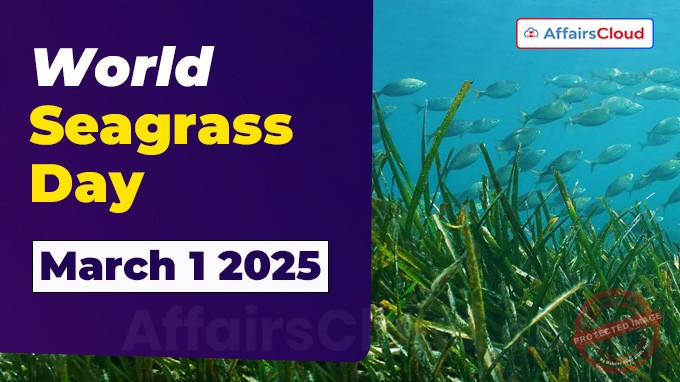 The United Nations (UN)’s World Seagrass Day is annually observed on 1 March across the globe to raise awareness of the importance of seagrasses as a fundamental element of marine biodiversity, the challenges they face, and their role in sustainable development and climate change mitigation and adaptation.
The United Nations (UN)’s World Seagrass Day is annually observed on 1 March across the globe to raise awareness of the importance of seagrasses as a fundamental element of marine biodiversity, the challenges they face, and their role in sustainable development and climate change mitigation and adaptation.
- 1 March 2025 marks the observance of the 3rd World Seagrass Day.
Background:
i.On 23 May 2022, the UN General Assembly (UNGA) adopted A/RES/76/265 declaring 1 March as World Seagrass Day.
- The resolution highlights the urgent need to raise awareness at all levels and to promote and facilitate actions for seagrass conservation to contribute to their health and development, keeping in mind that improving ecosystem services and functions is essential for achieving the Sustainable Development Goals (SDGs).
ii.This initiative started with a resolution from Sri Lanka, stressing the need to protect seagrass for future generations.
ii.The UNGA invited the UN Environment Programme (UNEP) to facilitate the observance of the Day.
iii.The first ever World Seagrass Day was observed on 1 March 2023.
Key Organisations:
The World Seagrass Day is co-organized by the UNGA, UNEP, the International Union for Conservation of Nature (IUCN), the Convention on Biological Diversity (CBD), the UN-OCEANS, the United Nations Framework Convention on Climate Change (UNFCCC), the World Wildlife Fund (WWF) the Ramsar Secretariat (RS), the United Nations Office for Disaster Risk Reduction (UNDRR), the Global Environment Facility (GEF) and the Commonwealth Secretariat (CS).
What are Seagrasses?
i.Seagrasses are marine flowering plants that live in shallow coastal waters on all continents except Antarctica.
ii.Covering only 0.1% of the ocean floor, they form vast underwater meadows that provide food and shelter to thousands of marine species and support some of the world’s largest fisheries such as the Alaska (walleye) pollock and the Atlantic cod.
iii.They improve water quality by filtering, cycling, and storing nutrients and pollutants, as well as stabilizing sediments, which helps to strengthen surrounding vulnerable ecosystems like coral reefs.
Key Facts:
i.Seagrass meadows exist in 159 nations across six continents, covering about 3,00,000 square kilometers (km2).
ii.At least 22 of the 72 seagrass species in the world are in decline, and since the late 19th century, about 30% of the world’s seagrass area has disappeared.
iii.Seagrasses are a component of the marine environment and store up to 18% of the global oceanic carbon.
Seagrass in Crisis:
i.According to the UN data, Seagrasses have been disappearing globally since the 1930s, with the most recent census predicting that 7% of this important marine habitat is lost worldwide per year.
ii.According to IUCN’s Red List of Threatened Species, 21% of seagrass species are considered Near Threatened, Vulnerable, or Endangered.
iii.Only over 25% of all meadows are located within marine protected areas, and this essential part of marine biodiversity is in danger despite its significant contribution to sustainable development, climate change mitigation, and adaptation.
About United Nations Environment Programme (UNEP):
Executive Director (ED) – Inger Andersen
Headquarters – Nairobi, Kenya
Established – 1972
Members – 193 Member States




